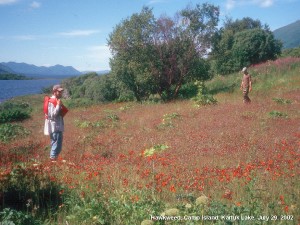Kodiak to host invasive species conference
October 26, 2012

907-474-5406
10/26/12
The Alaska Invasive Species Conference Oct. 30-Nov. 1 in Kodiak will highlight regional management efforts and emerging issues around the state.
Conference coordinator Gino Graziano of the University of Alaska Fairbanks Cooperative Extension Service said Kodiak offers a unique perspective on invasive species management. Many remote communities in the area rely on native fish, wildlife and plant species, however, the area is also home to several introduced species valued by subsistence and sport hunters, including the Sitka black-tailed deer, mountain goats and elk.
Conference presentations will focus on introduced wildlife, vegetation change and politics on the Kodiak Archipelago, non-native mammal management in the Kodiak National Wildlife Refuge and invasive species monitoring in Kodiak’s rivers.
Other topics will include invasive species on Japanese tsunami debris and other aquatic invaders, early detection and rapid response on public lands, and aerial surveys. Speakers will also talk about Chugach National Forest monitoring, economic impacts on the Annette Island Reserve and the devastating effect geometrid moths have had on blueberry patches in Seldovia and in Arctic Valley near Eagle River.
The conference also includes two free public lectures. Travis Tennessen, an instructor from Pennsylvania State University who grew up in Chiniak and Ouzinkie, will talk about the effects and politics of introduced wildlife on the Kodiak Archipelago. His lecture at 6:30 p.m. Oct. 27 will be in the Kodiak College Benny Benson Building. Steven Seefeldt, an Extension agriculture and horticulture agent from Fairbanks, will talk about orange hawkweed control Oct. 30 at 7 p.m. at the Kodiak Best Western Inn.
A preconference invasive plants curriculum workshop for teachers and agency educators is scheduled for 12:30–4:30 p.m. Oct. 29 at the Kodiak National Wildlife Refuge Visitors Center.
The conference agenda and registration information for the workshop and conference is linked from www.uaf.edu/ces.
The conference was organized by the Alaska Committee for Noxious and Invasive Plant Management and the Alaska Invasive Species Working Group, informal groups composed of agencies and organizations statewide.
ON THE WEB: www.uaf.edu/ces
ADDITIONAL CONTACTS: Gino Graziano, Extension invasive plants instructor, at 907-786-6315 or gagraziano@alaska.edu.
DSC/10-26-2012/119-13


